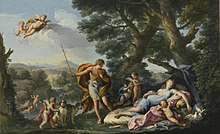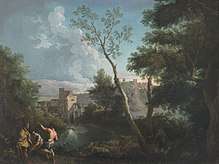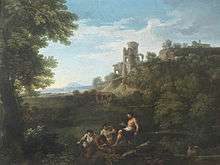Andrea Locatelli
| Andrea Locatelli | |
|---|---|
| Born |
19 December 1695 Rome |
| Died | 19 February 1741 (aged 45) |
| Known for | Landscape art |



Andrea Locatelli (19 December 1695 – 19 February 1741) was an Italian painter of landscapes (vedute).
Not a lot is known about the personal life of Andrea Locatelli, and much of that is due to the research of Andrea Busiri Vici who was considered the greatest Locatelli authority of the 20th century. He was responsible for the reintroduction of Locatelli to the present art world. This article is based on his book, Andrea Locatelli and Roman Landscape Paintings of the Eighteenth Century[1], published in 1976.
Andrea Locatelli (he spelled it Lucatelli) was born in Rome in 1695 – the month is not known with certainty.[1] This was stated by him at the base of a self-portrait drawing he made for Nicola Pio in 1723. He died, probably from tuberculosis, on 20 February 1741 as recorded by a contemporary artist friend Pier Leone Ghezzi.[1]:233 Andrea was the son of Giovanni Francesco Locatelli and not Pietro Locatelli, as has been previously reported. He studied under his father until 1708 and then under Monsa Alto who specialized in marine scenery. In 1792, at age 17, he along with Paolo Anesi became students of Bernardo Fergloni, also a marine genre specialist. By 1723, at 28 years old, he was referred to by Pio as a master. He was influenced by Jan Frans van Bloemen, Giovanni Ghisolfi, Gaspard Dughet, Claude Lorain, and especially Salvator Rosa. In turn he influenced such artists as Paolo Anesi Giovanni Paolo Panini, Paolo Monaldi, and Marco Ricci.[1]:228-230
The subject matter most popular with the academic artists of this time was mainly sacred, historical or mythological themes. Locatelli broke with these traditions and concentrated on landscapes, a genre thought to be “inferior” by the art critics of his day. In fact, he was never allowed induction into the Academia di San Luca, a very prestigious mark of honor, even though his work was in great demand. Vici considered that he was “the essential link in the evolution of European landscape painting during the eighteenth century.”[1]:234-235
Locatelli was patronized by kings, queens, princes, cardinals and the wealthy, not only in Rome, but also throughout Europe. One family- the Colonna- owned 81 of his paintings.[1]:231 At a time when it was becoming fashionable to make the Grand Tour, his paintings spread widely. Demand caused him to duplicate dozens of nearly identical ones. This may seem odd to us today, but at a time before photography, no one would have been aware of these “copies.” This was a very common practice by successful artists.
Early in his career, Locatelli specialized in romantic notions of the Latium countryside, frequently including improvised architectural elements of columns or buildings. Very few of these are thought to have been actual structures, although some were based on scenes along the Tiber and a well-known view of the Piazza Navona.[1]:249 In later years he leaned more to “grassy ruins” and countryside expanded with trees, peasants and farm animals being more prominent.[1]:237 Prior to about 1725, his works were considered “ruddy” in tone. A typical composition would contain figures of people or animals in the foreground with buildings in the midground and mountains or water in the distance. Balancing this horizontal pattern were vertical elements of buildings, columns and trees – especially large oaks or ilex rising up from the foreground. A frequent feature is the presence of broken trees or stumps and Mediterranean shrubbery.[1]:263
Vici said, “Locatelli’s landscapes are remarkable for the sense of solitude they convey despite the fact that they are populated by figures. There is a sense of seclusion, a quality that induced one to turn from the colourless life of the community to the joy of the isolation of an interiorized existence.” He excelled at the combination of a landscape with a peasant scene.[1]:264 276
Locatelli incorporated human figures and farm animals into his paintings and was considered skilled with horses. These became more prominent as his career advanced. He drew inspiration from the Bamboccianti, a group of genre painters who traveled to Rome from about 1625 to the close of the 17th century. Originally they were mainly Flemish or Dutch. The group derived its name from the nickname of Pieter Van Laer meaning “ugly doll or puppet” apparently a reference to his appearance.
Born in Rome, he was the son and pupil of the painter Piero Locatelli, who had studied with the Florentine Ciro Ferri. He next apprenticed under Paolo Anesi, although his style and thematic is akin to that of Claude Lorrain, and depicts small mythologic figures although within a wild environment more similar to those of Salvator Rosa. He is also known as Andrea Lucatelli. Andrea excelled in painting vedute in a style reminiscent of Jan Frans van Bloemen, one of the Bamboccianti. One of his pupils was Joseph Vernet.
References
- Vici, Andrea Busiri (1976). Andrea Locatelli and Roman Landscape Painting of the Eighteenth Century. Rome: Ugo Bozzi. OCLC 2777849.
- Farquhar, Maria (1855). "Lucatelli". In Ralph Nicholson Wornum. Biographical catalogue of the principal Italian painters. London: John Murray. pp. 90–91. OCLC 220878795. Retrieved 2008-11-29.
- Bryan, Michael; George Stanley (1849). "Lucatelli". A Biographical Dictionary of Painters and Engravers. London: H. G. Bohn. pp. 423–424. OCLC 8648216. Retrieved 2008-11-29.